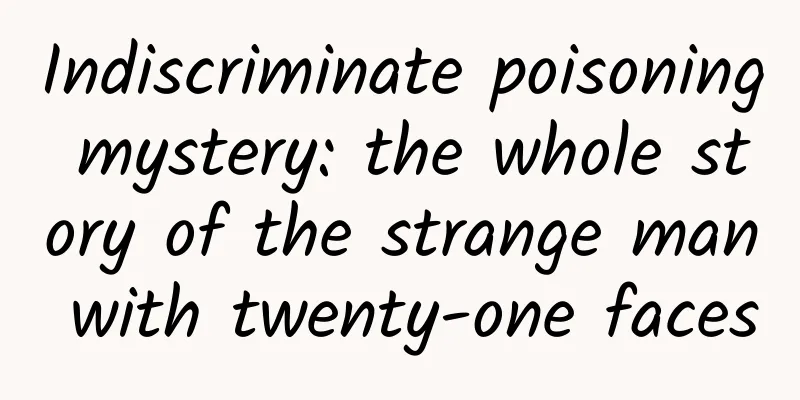Indiscriminate poisoning mystery: the whole story of the strange man with twenty-one faces

|
Leviathan Press: The incident of the strange man with twenty-one faces is also known as the Glico Morinaga incident, which had a huge impact on Japanese society at the time. After all, in the end, the way the incident developed to the end, using highly poisonous substances to threaten the lives of ordinary people (indiscriminate random poisoning) was indeed extremely terrifying. Going back further, in the 1970s, there was a Coca-Cola poisoning incident at Shinagawa Station in Minato-ku, Tokyo, Japan. The incident started in a public telephone booth, where a bottle of Coke containing cyanide was placed next to it: a girl became the first victim of the incident. Compared with the Coke poisoning case, since the criminals would give advance notice every time, in the Twenty-One Faces incident, no one was physically harmed by the poisoned food, but the economic and reputational losses suffered by the related companies were very huge. A portrait of the fox-eyed man, one of the suspects released by the police. © NAVER まとめ Many urban legends have been disproven, and people know that "poisoned Halloween candy" is just a legend, just as there is no "chewing gum laced with chemicals" or "caramel apples with razor blades hidden in them." Over the past many years, scholars have been working to decipher the source of these false news, believing that all these rumors come from a culture that causes anxiety - fear of strangers, fear of uncertainty, fear of consuming too much sugar, etc. In fact, now we can almost be sure that the worst thing your neighbors can do on Halloween is not to prepare candy at all, and maybe send your children away with a toothbrush or something else when they go to ask for candy. Yet for most of Japan more than 30 years ago, this irrational, deep-seated fear was actually playing out in real life. For a year and a half, a mysterious group blackmailed Japan's largest candy companies. The group mixed candies laced with cyanide on supermarket shelves. They also wrote a large number of letters, carefully worded and provocative, detailing the details of the poisoning. These letters were sent to Japan's largest newspapers and published. During this period, they repeatedly thwarted the investigation and morale of the Japanese police. To this day, no one knows who they are. They called themselves "Kaijin 21-mengxiang" (かい人21面相), and they turned all Japanese people's love for candy into deep fear overnight. On March 18, 1984, Katsuhisa Ezaki returned home from a long day at work, took off his suit, and settled into his bathtub. At the time, Katsuhisa Ezaki had been president of Ezaki Glico Corporation (江崎グリコ株式会社) for almost two years, a multimillion-dollar food company based in Osaka, Japan. The company made everything from ice cream to hamburger patties, but was best known for its sweets—pudding, Pocky bars, and Glico candies, which use the nutrient-rich glycogen in oyster broth. (www.glico.com/global/about/history/product) That night, Ezaki had just soaked in the bathtub for a while when he heard a commotion somewhere in the house. Suddenly, two masked men burst in with weapons, rushed into the bathroom and dragged Ezaki out of the bathtub. Ezaki shouted for help, but the masked men had expected him to do this - they had tied up Ezaki's wife and daughter, cut off the phone line in the house, and even broke into Ezaki's mother's house next door and tied up his mother as well. Then, the two men dragged Ezaki outside the house, gave him a coat and a ski hat, and finally took him to an isolated and nameless warehouse. The next day, when the police searched for clues about Ezaki's whereabouts at his home, they found a note near the phone. Through this note, the kidnappers demanded 1 billion yen (equivalent to 4.3 million US dollars in 1984) and about 100 kilograms of gold bars as ransom. Just as the detectives were investigating the clues, just two days later, the imprisoned Ezaki successfully escaped from the warehouse. Of course, everyone hopes that the kidnappers will be brought to justice and the incident will be settled. However, this is just the beginning. About three weeks later, the editorial offices of the largest newspapers in Japan simultaneously received some strange letters. "To the stupid policemen," the letters began, "Are you idiots? ... If you were experts, you would have caught us. Because the difficulties you idiots may have encountered are too great, we decided to give you some hints." Then, the letter listed some details of the crime in the following text - the car used for escape was gray, and the food they had eaten in the past few days was bought from Daiei Supermarket (one of the largest supermarket chains in Japan). The letter even had a more provocative question: "Should we kidnap the police inspector of which county?" (Police inspector is a police rank in Japan, equivalent to the Self-Defense Force rank "General", i.e., lieutenant general)" Of course, the final signature of this long letter was the strange man with 21 faces. All major newspapers published this letter. In addition, in the following months, several newspapers also published some subsequent letters: the newspapers received dozens of long letters in total, all of which were extremely sarcastic and full of useless clues. While some of the letters were written purely to provoke the police, many of them foreshadowed the group’s future criminal activities. For example, a letter in mid-March claimed that the group had added cyanide to some Glico candies, but the letter did not specify which product had been poisoned. Glico immediately decided to remove all candy products from sale. Although no cyanide was found in the recalled products, these inspection reports could not save the company's reputation. The shocked Japanese launched a boycott against Glico. According to the New York Times report that year, "the whole society has become alert to Glico's products. The most typical case is that when a Tokyo office worker wants to give her friends some chocolate gifts, she will attach a note indicating that the chocolates are produced by other companies." Soon, Glico's market value plummeted, and they had to lay off more than 1,000 employees. (www.nytimes.com/1984/07/02/world/the-great-candy-caper-leaves-all-japan-atwitter.html) Although the mysterious gang was never caught, they captured the public's imagination. Their letters and tactics were so dramatic that they were morbid but fascinating. They demanded huge cash payments from candy companies but never showed up to collect them. (There is no evidence that they ever received any money.) They also instructed a Glico employee to go to a specific phone booth at a specific time and wait there for a call - but when the disguised police showed up, they didn't call. On the second day of the operation, the mysterious organization sent another letter to provoke the police: "Do you think you can fool us? Do you think those beautiful navy blue suits and those acting skills pretending to be working class can fool us? Those sneaky eyes have already exposed you." This shows that the organization is monitoring this operation in some unknown way. The Japanese newspaper Yomiuri Shimbun once said in an editorial: "We can't find any similar criminal activities. The police have never been fooled by criminals like this." The letters show a colloquialism similar to that of Osaka, which was the third largest city in Japan at the time, and whose unpretentious appearance was seen as a symbol of anti-capitalism. Ivy points out that compared with the formality of standard Japanese, Osaka's dialect leaves a lot of room for sincerity, sincerity and humor. In addition, the city has been associated with comedy for more than 1,000 years, and many of Japan's most famous comedians come from the city. Ivy also said: "It is precisely by borrowing this dialect that the author makes the murderous hints that are often hidden in the words clear." In other words, when Japanese people open the newspaper and read the latest provocations and threats from the strange man with twenty-one faces, they actually read the subtext of the letter: "Why so serious?" In June 1984, the mysterious group sent another letter, this time beginning "To our fans throughout Japan," and announcing that they were going to let Glico go. "The president of Glico has been walking around with his head down lately," they wrote, "We have decided to forgive him." Of course, the letter made fun of Glico as usual, "There is a 4-year-old child in our organization who cries for Glico every day. It is really annoying to let a child who has been deprived of his favorite candy cry like this." In addition, the letter did not forget to make a harsh joke of the police, "The police are doing a great job - hang in there, don't give up!" They ended their letter with a preview, first asserting that "Japan is getting too hot and humid right now." Then they continued: "So when our 'work' is done, we'll be in Europe - Geneva, Paris, London - we'll be in one of these 3 places... Don't forget to bring Pocky, the traveler's best friend! Glico's delicious products - we're eating them too! See you next January!" But the mysterious organization reappeared before the predicted time. In September 1984, they targeted Morinaga Confectionery Co., Ltd., another old Japanese candy food company. This time they directly demanded $400,000, but Morinaga did not meet this demand. So on October 8, major Japanese newspapers published another letter: "To all mothers in Japan: In autumn, when appetites are good, candies are extra sweet. When you mention candies - no matter what you say - Morinaga is the best. We add some special seasoning. Potassium cyanide tastes slightly bitter. But it doesn't cause tooth decay, so buy candies for your children. We have specially marked the toxic candies on the packaging. We put 20 boxes in supermarkets from Hakata to Tokyo." Morinaga's stock price immediately plummeted 22 points. The next letter also warned that if major supermarkets did not immediately boycott Morinaga's products, they would continue to poison candies, but this time they would not post warning stickers. "This is like a treasure hunt," the mysterious organization said in the letter. This time, the Japanese police mobilized unprecedentedly. Because the police noticed that the mysterious organization tended to carry out poisoning activities on Saturdays and Sundays, the police mobilized 40,000 police officers - equivalent to 20% of Japan's police force - to patrol in plain clothes in major supermarkets for several consecutive weekends. When they carefully checked the surveillance videos in the supermarket, they finally found a man with curly hair, a baseball cap and glasses placing something on a shelf in one of the videos. They also traced the letters back to which typewriter they came from. They released the recording of the blackmail call to Morinaga Confectionery, which recorded the voices of a woman and a child asking for money - they also set up a hotline for this recording so that people can call the hotline and listen to the voices in the recording. But all the clues slowly fell into disuse, which brought more ridicule to the police. One of the letters asked, "Doesn't the guy in the video look sunny?" Then, the letter began to compare the appearance of several famous police captains (Japanese police ranks, equivalent to the Self-Defense Force ranks "San Zuo" to "First Lieutenant", that is, major to captain) with the suspect in the video. After a police surveillance and arrest operation in Shiga Prefecture failed, the police only tracked down a van abandoned by the suspect, which was full of strange equipment - a vacuum cleaner, a wide-brimmed hat, a pair of wire cutters, etc. - the weird man with twenty-one faces soon sent a letter declaring: "You can't track us through the things we discarded." During that period, they constantly extorted money from candy companies: for example, they extorted 100 million yen from Fujiya (Fujiya Co., Ltd.) and 50 million yen from Surugaya (Kyo Sanjo Surugaya). On August 7, 1985, due to deep remorse and blaming his subordinates for the poor handling of the case in the previous arrest operation, Shiga Prefecture Police Chief Shoji Yamamoto poured kerosene on himself and burned himself to death to apologize. Even for this mysterious group, this incident was extremely shocking. Five days later, they sent their last letter. There was a paragraph in the letter that read, "Retired Yamamoto died like a man. Therefore, we decided to offer our condolences. We decided not to torture food companies anymore... We are bad guys. This means that we have other things to do besides torturing a few companies. It's fun to live as bad guys. Twenty-one faces of weirdos." After this letter was published, they disappeared. In the following years, the police have been trying to find clues and lock suspects. Some clues point to notorious underworld forces. Others point to extreme left or right organizations, or forces from North Korea. In this case, the police investigated a total of 125,000 people and tracked down 28,300 clues provided by the public. However, everyone's alibi was established, and those clues failed to spark new sparks. The statute of limitations for the Ezaki kidnapping case expired in 1995. The statute of limitations for the cyanide chocolate poisoning in Aichi Prefecture also expired in 2000. Michael Newton wrote in his book The Encyclopedia of Unsolved Crimes: "Even if we knew the identity of the 21-faced man today, he and his accomplices could not be prosecuted or tried." Today, the 21 masks of these weirdos still conceal their true identities. This mysterious organization has not disappeared - they are still lurking in people's occasional memories of those terrible letters, and they still make you hesitate for a moment when you reach for a Pocky chocolate bar. Because they could be anyone, they can hide among everyone. As a letter that was published when they dominated the public with terror said: "Who are we? Sometimes we are a policeman, sometimes we are a gang member... sometimes we are factory workers, sometimes we are kidnappers... but our true identity... is a weirdo with twenty-one faces!" Perhaps our understanding of this unsolved case will end here. By Cara Giaimo Translated by Lupin the Third Proofreading/Kinda Kazuichi Original article/www.atlasobscura.com/articles/the-1980s-crime-ring-that-poisoned-japans-candy-and-never-got-caught This article is based on the Creative Commons Agreement (BY-NC) and is published by Lupin III & Kindaichi on Leviathan The article only reflects the author's views and does not necessarily represent the position of Leviathan |
<<: Why is green tea called green tea? The difference between black tea and green tea
Recommend
How many months of pregnancy do you start to gain weight?
After pregnancy, because there is already a baby ...
[Health Lecture] How do kidney patients on dialysis spend the winter?
As the winter cold wave arrives, the temperature ...
Eat three meals a week? Beware of cancer caused by this "feeding"
Review expert: Peng Guoqiu, deputy chief physicia...
Is it normal to have brown discharge when you are 40 days pregnant?
A woman is still in the early stages of pregnancy...
Can I do leg slimming exercises during menstruation?
Women will experience various discomforts during ...
Pregnancy belly is hard
It is relatively easy for people to get pregnant ...
Causes of left side back pain in women
When it comes to lower back pain, not only men ha...
What are the symptoms or feelings of embryo implantation?
Some families may be anxious to have a baby, and ...
Three kinds of healthy and delicious scented teas, why don’t you try them now!
Nowadays, many women like to drink scented tea. D...
What to do if you have pubic lice? What medicine to use?
For women, it is very important to keep themselve...
How to control the chatter in your brain?
Leviathan Press: When you read this text, what is...
What should girls do if they have long nose hair?
Some girls have the problem of long nose hairs, s...
Feeling sleepy after school starts? Here are 3 tips to help you adjust your biological clock!
During such a long holiday, many people have beco...
What types of range hoods are there? How to use range hoods correctly in winter
The types of range hoods we use at home include s...









